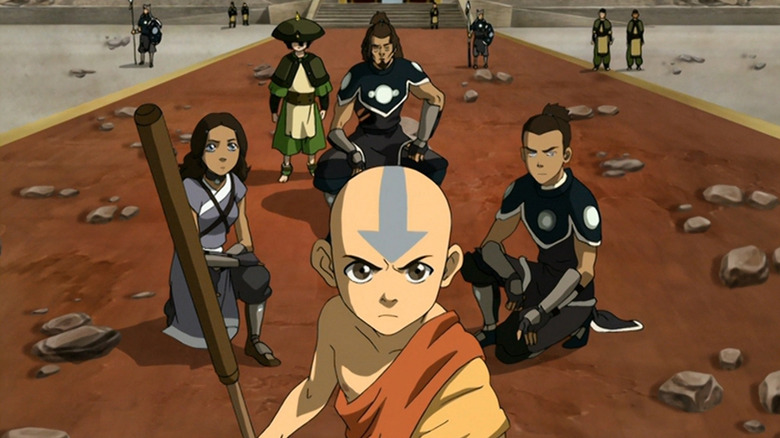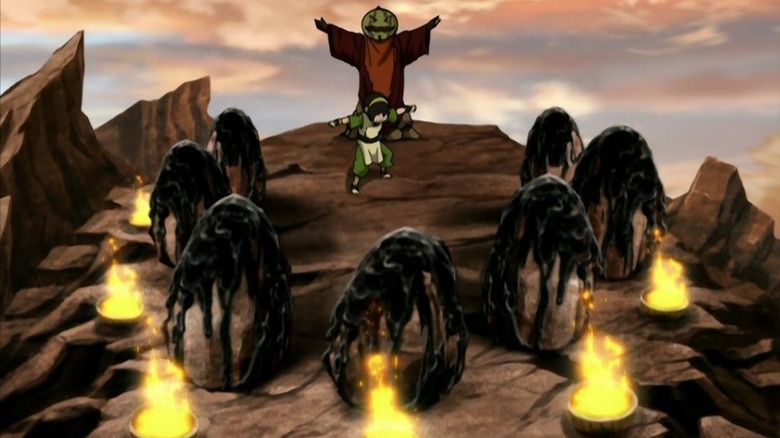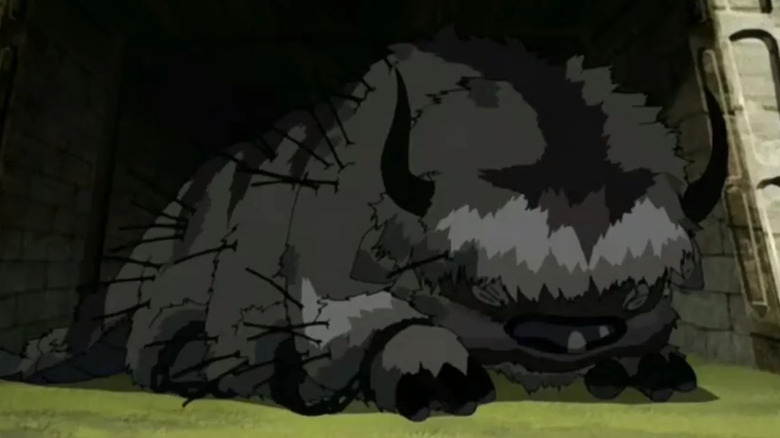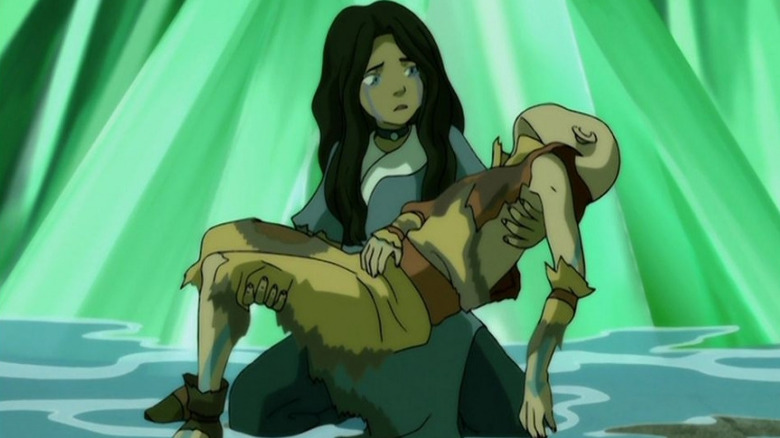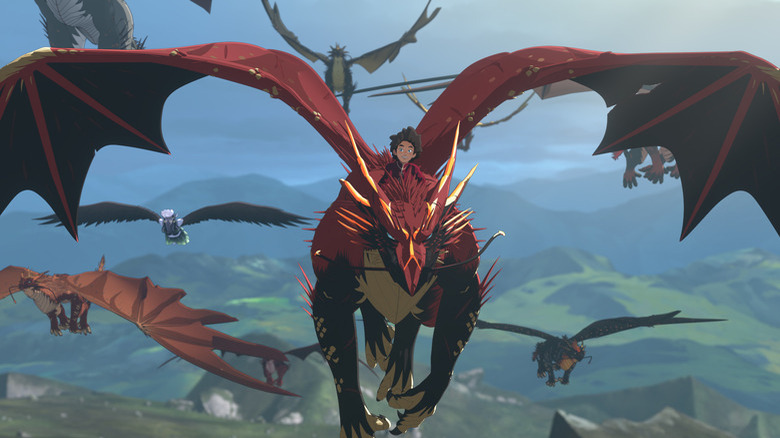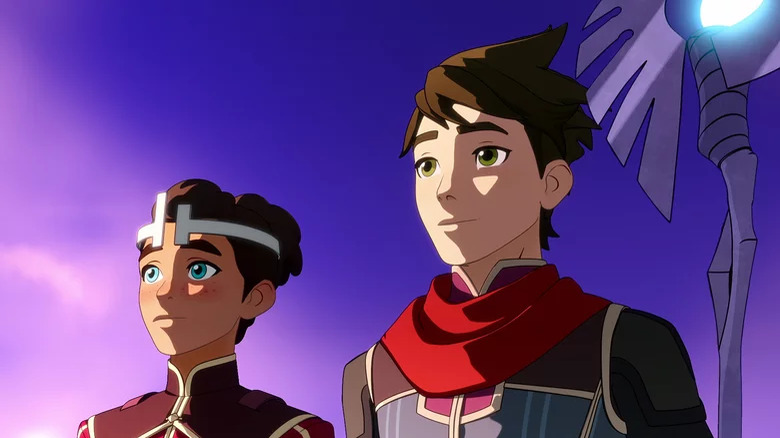Avatar: The Last Airbender Head Writer And A Standards & Practices Veteran Explain Why You're Wrong About Studio Notes [Exclusive Interview]
(Welcome to My Most Ridiculous Note, a series of interviews in which animators talk about the weirdest and funniest notes they received from studio executives.)
Well folks, this is a special occasion. For a while now, we've been publishing interviews with animators who worked on some of the most beloved cartoons of the '90s and '00s, exploring what went into making those stories stand apart from their contemporaries, from the Christmas episode of "Hey Arnold" to the classic "Nosferatu" joke in "SpongeBob SquarePants."
We've also explored the bizarre, over-the-top notes that studio executives, as well as Standards & Practices folks, have given to animators. There have been stories of ridiculous notes, sensible ones, and everything in between, but this interview series has (understandably so) focused on the side of the animators who try to get their work out and are met with some roadblocks. This time around, however, we're bringing you something different: a conversation with both an animator and a former director of standards and practices at Nickelodeon.
George Lentino has worked overseeing standards and practices for 25 years on all kinds of cartoons, and Aaron Ehasz is the co-creator of "The Dragon Prince," one of the best fantasy shows on TV regardless of medium, and served as head writer on a little show called "Avatar: The Last Airbender." The two discussed misconceptions about S&P, and when it can lead to better storytelling or lead to conflict.
'Water. Earth. Fire. Air'
Released in 2005, "Avatar: The Last Airbender" remains a show like no other. Inspired as much by the works of Studio Ghibli and "Shaolin Soccer" as it is by fantasy epics like "The Lord of the Rings," this cartoon marries Eastern and Western aesthetics to create a unique look. It also featured a variety of martial arts to create exciting and dynamic action scenes that felt closer to Jackie Chan movies and action anime than, say, "Teenage Mutant Ninja Turtles."
One of the first conversations with standards and practices was about the action, specifically the firebending, one of the four main bending techniques, and also one with potential "do not try this at home" issues. As Lentino remembers is, Nickelodeon executive Eric Coleman met with him and explained, "Hey, we've got this show, there's going to be fire in it. How do we do fire?" Coleman spoke about how firebending would work in the show, and made it clear it would not be about burning people alive. Lentino, who appreciated Coleman's willingness to solve problems ahead of time by coming to standards and practices early, responded positively to the idea. "I was like, 'Well, as long as we're not burning people alive, I feel like there's ways of making this happen,' and clearly they made it happen."
The show also had exquisite storytelling and vast world-building full of deep and rich mythology, a history that spans centuries, multiple cultures and lore, and one of the best character arcs in modern TV. Indeed, "The Last Airbender" has some heavy subjects for a show that aired right after "SpongeBob" and also had plenty of kid-friendly jokes and cute animal companions, from genocide and the obliteration of an entire culture to war and fascism — not exactly what comes to mind when you think Nicktoons.
"We were aware that the story had deeper implications and themes," head writer Aaron Ehasz said. "But at the same time, we knew that a lot of our audience was going to be younger." To balance the two, "The Last Airbender" had enough action and humor that a six-year-old could easily perceive and enjoy, while having those deeper themes they can understand when they rewatch the show as older kids. And as Lentino explained, tackling difficult or complex ideas is also as much about the delivery system as it is about the message itself.
"Think about an audience hearing 'death, dying, genocide' over and over and over again in a 45 second scene. What does that convey? And is that what you guys want to convey? And then take a look at that. That's always the way I would approach it with the [creative team]. Then they think about it, and they would always be the ones who would make the best decisions on this. Standards and practices just guides and makes suggestions, and they put together the good stuff."
An example of this comes in the first part of the four-part finale, when Aang is preparing to fight the Fire Lord with a wooden dummy with a melon as a head — dubbed Melon Lord — and hesitates to think about killing his opponent. In the final version of the episode, Sokka slices the melon in half off-screen to show how it's done. According to Ehasz, the script originally had the full melon head being knocked off, which led to discussions about what to show. "It's okay to destroy the melon or cut the melon in half, but something about doing it where you're actually lopping it off as the head of the thing had a different, almost more realistic and scary impact," the writer said, describing the sliced-off half of a melon just dropping without showing the act as "not as visceral and suggestive of a decapitation." It's just as much about the delivery as it is about the message.
It's about empowering, not sanitizing
While there are many shows and movies that joke about standards and practices, they tend to focus on the conflict between company and creator and the limitations placed on creativity. For Lentino, it is important to dispel that notion and also highlight that S&P "has always been about helping the creators get on air what they want to get on," and about guiding the filmmakers early on so the final product stays as close to the original vision as possible. "My philosophy also is, if you get to the animation stage, and I have a standards and practices note, that means I made a mistake," he said. Of course, it doesn't always work that way. "I've definitely had other encounters with [standards and practices] people who almost seem like they're trying to sanitize [the show], or reduce liability," Ehasz added.
When it comes to "The Last Airbender," Ehasz and Lentino agree that the show seemingly managed to do so much with its limitations because of the way it tackled its heavy subjects. Take Jet, for example, one of the best-written and complex characters, a young rebel who wasn't above drowning an entire village of innocent people to defeat the few soldiers stationed there. Jet met a tragic death in season 2 — not that the show outright told you he died, of course.
"I remember the biggest conversation we had was about Jet," Lentino said. "There's a little bit of vagueness to [Jet's death], but not really." Indeed, what we see is a heavily injured Jet staying behind to fight some elite Earth Kingdom forces while Aang and the gang escape, his future uncertain, but not looking good. "It was this complicated math involving Toph could tell whether he was lying," added Ehasz. "[Jet] said, 'I'm going to be okay.' But then [Toph] was like, "He's lying." That was the math that lets you figure out he was not going to be okay."
Something similar happened with one of the most traumatic and tough-to-watch storylines in the whole show: when Aang's faithful flying bison, Appa, gets kidnapped. When we finally catch up to him, we see he's suffered at the hands of a sadistic circus owner. "We knew who was right and wrong in that story a little bit," said Ehasz. "It's more about understanding it and facing it in a way that can lead to, hopefully, good growth." Lentino agreed, adding, "We've got the bad guys, we've got a clear delineation, we're not supporting them in any way."
Planning ahead
"The Last Airbender" was obviously not the first animated show to tell a serialized story over the course of several episodes. But "Avatar" was still significant in how its story was allowed to continue over three seasons and tell a complete, epic fantasy story with a beginning, a middle, and an end. Though it is commonly believed that the show was planned out from the very beginning, with Nickelodeon giving creators Michael Dante DiMartino and Bryan Konietzko three seasons from the start to tell the story, the truth is not that simple.
As Ehasz tells it, "Avatar" was constantly fighting to tell its story, and even if certain elements — Aang learning all four elements, Zuko becoming a good guy — were thought of ahead of time, completing the story was never a guarantee.
"When I got brought on, they had just gotten greenlit for five scripts, and my job was to make sure those five scripts were strong enough that they would order a season of the show," said Ehasz. "So we did those scripts, and then we got greenlit for 13 episodes. It wasn't even 20." Wanting the network to realize the potential of the story, they ended those 13 episodes on a high note, which is why episode 13 is "The Blue Spirit," largely considered one of the best episodes of the entire show. After the rest of the first season was picked up, the show once again ended its possible run on a high note, with "The Siege of the North."
Even when season 2 got picked up, there was no guarantee for a third season, which led to the huge cliffhanger in which Aang got hit with lightning, his fate uncertain. "They did not pick it up after season 2," Ehasz revealed. "The ratings were not strong enough! They did not pick it up. We laid off all the writers after season 2. Everybody was sent home for three or four months."
It wasn't until Nickelodeon's Eric Coleman started campaigning for the show to the rest of the Nickelodeon brass that season 3 was confirmed, but the writers and the rest of the team were still away. "So there was a rolling hiatus through all of season 3, where all the storyboard artists had to take a couple months off, all the designers had to take a couple months off. Everyone did, because we had to catch up again on the scripts. So 'Avatar' was essentially default cancelled between season 2 and season 3. People do not know that. So there was always love, but there was not always obvious success and ratings for 'Avatar.'"
Finding the right balance
Aaron Ehasz's other show, "The Dragon Prince," can be considered a sort of spiritual successor to "Avatar." It retains the same sense of humor of the Nickelodeon show, while introducing a vast new world rich with lore, and an epic fantasy with great action and a story that grows with its characters.
While "Avatar" was all about a very small group of kids bringing hope back by fighting against a mighty empire, "The Dragon Prince" is set in a world of big kingdoms with huge armies, which clash in an epic battle at the end of the third season. According to Ehasz, that battle led to lengthy conversations with the standards and practices department.
"Some of that was how do you convert [...] what were violent moments into moments that, to a younger audience, are going to feel like exciting action but are not terrifying?" the creator explained. "So you're not going to want to show an arrow sticking out of Kasef's eye [...] some of that was camera angles." Also important was to break the battle into sections, so "if there is a scary moment or an intense moment, it's not followed by another one and another one and another one."
Like "Avatar," the story of "The Dragon Prince" is becoming more complex with each season, with Ehasz's goal being a show that grows up with its audience the way "Harry Potter" did. "In season 5, there's a scene that is pretty insane [...] it's a horror scene," Ehasz said.
"The initial feedback I was giving the team was like, 'We can't show all this stabbing,' basically. So I got back this version where it was very obscure, but there was a lot of screaming, and it was still terrifying. So some of it was converting the terror into suspense kind of terror, of really getting it to be where it's more about, you're hearing footsteps, you're seeing someone's eyes get really wide, those moments. And then before the thing happens, seeing it come in on their eyes and going to black. No screaming, no stabbing ... It's choosing where you leave the dials."
Now, the "Harry Potter" series did grow up with its audience, literally, as it also changed ratings along the way, with the last movie being PG-13. Though Ehasz doesn't promise anything, he confirms something similar has been discussed. "We've had signaled to us support from Netflix that, if the story takes us in that direction, they're going to support us even if the rating changes." Granted, don't go expecting a hard-R season, but Ehasz said the show "might start to push up against something that is more PG-13 in the next couple seasons."
It's all about the delivery of the message
This interview series was inspired by the news earlier this year where Alex Hirsch published some of the very real notes he received from Disney when making "Gravity Falls." When asking George Lentino about it, he confessed he'd still have given the same notes, but it's all about how you do it.
"I think that there's a technique and a way of doing that, because sometimes those notes feel super condescending and super patronizing," Lentino said. "I always explain, 'This is how it's striking me. I might be totally wrong, but I'm a person who loves this show, can you just tell me what your intention...' Or, 'Think about this?'"
While we've posted several anecdotes of funny notes given by execs, it was clear we had to get the opposite — some funny notes S&P received from animators. Lentino tells of a script he got that already anticipated the notes he'd give them, describing a magical creature character that goes down a deep hole under the water. "And then there's a note, 'Hey George, don't worry, this won't look like it's somebody's butt.'"
The most important thing to a standards and practices representative has to be an admiration for the work, according to Lentino. "That respect for their work, it has to be there. It has to be there. [Animators] are trying to make good stuff, and if you get in the way of that, you just are a big, giant moron."
